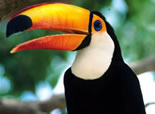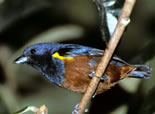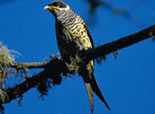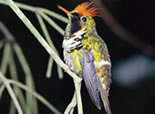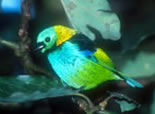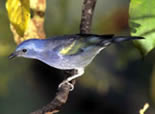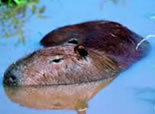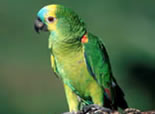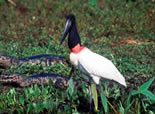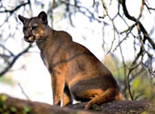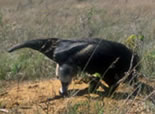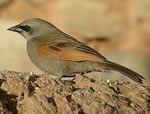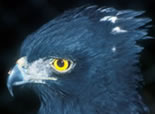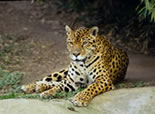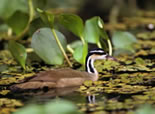Brazil
|
Brazil, one of the most fantastic countries in the continent, is also the largest. Its range extends north and south of the Equator, and is covered by forests, savannas and arid lands. It has one of the richest levels of biodiversity known, but sadly much of that is disappearing due to human activities. Being so vast, there are areas of the country that remain little known. Even new species are still discovered; some of them in well known places or in proximity to towns and cities! There are about 1700 species of birds in Brazil, with an amazing 10% of endemics. To these add a mammal list that includes some spectacular ones, plus the colorful butterflies and weird jungle insects. From the Atlantic rainforest to the Amazon, and through the central savannas of the "Cerrado" and the Pantanal, Brazil offers an immense number of surprises and attractions to all nature lovers. The wide variety of the accommodation available, the tasty and plentiful food and the friendly people, makes a trip to Brazil an unforgettable experience. |
|||
|
Country Hightlights
|
This region is like a long slip extending from the very south of the country to the very tip in the northeast. It presents a series of small mountain chains with low valleys in between, so the variety of habitats and birds is so big. In spite of having suffered from high levels of deforestation, mostly in the lowlands, there are still important patches of forest left. These forests are very lush, resembling the cloud-forests in the mountains, and the Amazon in the lowlands. They have evolved in isolation from others like the Amazon, developing a level of endemism among the highest in the world. This is added to the complex system of mountains and valleys. The resulting stunning level of endemic species found in this region, not only of birds, meant that it was designated as one of twelve "Hotspots of Biodiversity" in the world. In spite of having suffered from severe deforestation, there are luckily still numerous areas of natural habitats. |
|||
|
|||
|
Some of the birds to be looked for here are numerous antbirds and antshrikes like Tufted and Giant, Spotted Bamboowren, Fork-tailed Tody-tyrant, flocks of colourful tanagers, and simply too many more to mention. Many of these are currently considered Globally Threatened with extinction. Some fantastic patches of forest can be found no more than 6 hs drive from either Sao Paulo or Rio de Janeiro; the Intervales Reserve, and the Itatiaia and Serra dos Orgaos national parks. Throughout the rest of the Atlantic forest one can find other types of vegetation as coastal forests, monkey-puzzle (Araucaria) forests, mangroves, and high altitude grasslands up in the mountains, at 2700 m (8850 ft) in Itatiaia. Some spectacular birds include Araucaria and Itatiaia Tit-Spinetails, Chestnut-headed Tanager and Bahia Antwren. The region has amazing scenery at many spots, and of course a variety of other wildlife. It is really high in the list of priorities for nature travellers visiting Brazil. |
Country Hightlights
|
In southwest Brazil is The Pantanal, the largest wetland in the continent and a real must for birdwatchers and nature lovers in general. Birds are everywhere, and in big numbers. Water-birds such as American Wood Stork, Jabiru and Roseate Spoonbils congregate by thousands in drying pools of water. Flocks of parrot and parakeet, Piping-Guans and raptors like Crane Hawk, Savanna, and the beautiful Black-collared Hawk fill some of the picture, along with a myriad of passerine species, including the endemics White-lored Spinetail and Matto Grosso Antbird. But the absolute star in the area is the globally threatened Hyacinth Macaw. The largest of all parrots, deep blue in colour, it has one of the loudest bird shrieks that you'll ever hear! It is a bird that will never cease to amaze you. The region is also famous for its other wildlife. Mammals (and reptiles) also share some of the stardom here. Hundreds of Capybaras roam in the marshes (in close company to Yellow Anacondas and huge Caimans!). The caimans all pile up in hundreds along the shores of water pools. Howler Monkeys fill the air with their weird, guttural voices. Marsh and Brocket deer can be very confiding. Giant Otter, Giant Anteater, Tapir, and Capuchin Monkey are likely. The real highlight of the trip may come from the cat section. Jaguarundi, Ocelot and Puma could be found. But the biggest prize is obviously the Jaguar. The Pantanal is in fact one of the best areas in the continent to go after this beautiful creature. |
|||
|
|||
|
The Pantanal gives travelers the chance of having a most relaxed and rewarding birding trip. From the city of Cuiaba, a good dirt road (Transpantaneira) gives access all the way to the heart of the Pantanal, at the Cuiaba river. The 140 or so wooden bridges along it are legendary. Along this road are a number of “fazendas” (ranches); situated among the wilderness, and represent birding spots themselves. Many ranches still manage their lands for cattle ranching, but also offer comfortable lodging, with woodlands and streams at your doorstep. By paddled boats you will explore up and down some of the streams. There are side roads and trails, but a lot of birding, photography or sightseeing can be done from the vehicle. The open landscape results in great opportunities for this. |
Country Hightlights
|
Not far from the Pantanal, beyond Cuiaba to the north, the road climbs up a plateau that reaches about 800 m (2600 ft). Everything changes as you arrive to the “Cerrado”. A huge area of Central Brazil is covered in it, with grasslands, light woodlands and forests, and is situated in an extensive plateau: The “Planalto”. The edges of the escarpments at the Chapada dos Guimaraes provide one of the most amazing scenery shows. Not only the wide gorge and the red sandstone, but also the 86 m (282 ft) waterfall, and the Red-and green Macaws help make this a really amazing spot. Other great birds are Olive Crescent-chest, Blue Finch, Fiery-capped Manakin, White-rumped and White-banded Tanagers. The local town is just over an hour drive from Cuiaba, so it is almost mandatory to visit the Chapada during a trip to the Pantanal. There are other great spots to visit within the huge area of the cerrados, which also provide a variety of sights and landscapes. |
|||
|
|||
|
This part of region can be accessed from Belo Horizonte. A short drive to the Serra do Cipo will get you to nice cerrado habitat, and further up the hills there are rocky fields, with endemics such as Hyacinth Visorbearer, Cipo Canastero, Buff-throated Serra-Finch and others. A different way from Belo Horizonte is another “serra” location, the Serra da Canastra National Park. Besides the beautiful landscape and a huge waterfall, it is the best known site to see the Critically Endangered Brazilian Merganser. It really produces a thrill to find it in the crystal clear streams. Other interesting species here are Stripe-breasted Starthroat, Brasilia Tapaculo, Sharp-tailed Grass-tyrant, and Ochre-breasted Pipit. Manned Wolf, Giant Anteater, and even Giant Armadillo can be found driving up and down the roads up in the serras. As usual in most of Brazil, the birding locations in this region are provided with good quality accommodation and infrastructure, and are well located in close proximity to the natural areas. |
Country Hightlights
|
The fantastic Amazon Rainforest is famous worldwide for its impressive levels of biodiversity. Most of the amazon region lies within Brazilian territory, extending from the foothills of the Andes to Central Brazil. A myriad of rivers, streams and rivulets dissect the Amazon, carrying the water from the Andes into the mighty Solimoes (Amazon) river, one of the largest in the world. You can picture this as a pattern of veins in a leaf. Two main forest types can be found. The "Terra Firme" forest is what most people thinks of as "typical" Amazonian forest, with a dense structure, and complex layer of plants like vines and smaller trees along the whole range of height. All through this region the tall forests could reach up to 50 m (164 ft). But along the complex network of the river system, another type of forest grows: The ?Varzea?. During 6 months of the year it will be flooded by 10- 15 m of water, the overflow from the many rivers and streams. |
|||
|
|||
|
The ecologies of all organisms living there have adapted to this complex cycle. Each of these forest types contains a large number of species of course, with several specialties in each. Bird-life is very rich. Toucans, parrots, antwrens, woodpeckers, and flocks of colourful tanagers roam the dense canopies of the terra firme. Along the lower half of the vegetal structure you will hear the cacophony of antbirds calls and songs. Among these are the amazing "professional antbirds", which spend most of the day following the fear imposing ant-swarms. The ants will devour anything along their way, while the antbirds will jump around to catch what was lucky to escape from the earlier predators. Foliage-gleaners, spinetails, wood-creepers, tinamous and several manakins are also found joining sometimes very large mixed species flocks, and all moving at different heights. This birder's paradise can be explored in several loges along the country, all conveniently built inside the forests, reasonably close from towns or villages, and of generally easy access. They have good networks of trails into the forests, and several have built observation towers that allow one to get eye-level views of the canopy. The Varzea will instead be explored from a small boat, giving one access deeper into the forest, or to chase after any birds. Very species rich as well, this habitat has special antbirds, antwrens and woodcreepers, and any wider spot along the waterways can give good views of the canopies on the other side. |

